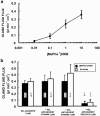Tachykinin NK3 and NK1 receptor activation elicits secretion from porcine airway submucosal glands
- PMID: 12522097
- PMCID: PMC1573655
- DOI: 10.1038/sj.bjp.0705029
Tachykinin NK3 and NK1 receptor activation elicits secretion from porcine airway submucosal glands
Abstract
1 We presently characterized the tachykinin receptor subtypes, using tachykinin receptor agonists and selective antagonists, that induce submucosal gland fluid flux (J(G)) from porcine tracheal explants with the hillocks technique. We also investigated the effects of the tachykinin receptor agonists on the electrophysiologic parameters of the tracheal epithelium in Ussing chambers. 2 The NK(1) tachykinin receptor agonist substance P (SP, 1 microM) and the NK(3) tachykinin receptor agonist [MePhe(7)]neurokinin B ([MePhe(7)]NKB, 1 microM) induced gland fluid fluxes of 0.29+/-0.03 microl min(-1) cm(-2) (n=26) and 0.36+/-0.05 microl min(-1) cm(-2) (n=24), respectively; while the NK(2) tachykinin receptor agonist [betaAla(8)]neurokinin A (4-10) ([betaAla(8)]NKA (4-10), 1 microM) had no effect on J(G) (n=10). 3 The NK(1) receptor antagonist CP99994 (1 microM, n=9) blocked 93% of the SP-induced J(G), whereas the NK(3) receptor antagonist SB223412 (1 microM, n=12) had no effect on the SP-induced J(G). However, SB223412 (1 microM, n=9) blocked 89% of the [MePhe(7)]NKB-induced J(G) while CP99994 (1 microM, n=10) did not affect the [MePhe(7)]NKB-induced J(G). The NK(2) receptor antagonist SR48968 (1 microM) did not block the J(G) induced by either the NK(1) (n=4) or NK(3) (n=13) receptor agonists. 4 The nicotinic ganglionic acetylcholine receptor antagonist hexamethonium (1 microM) and the muscarinic acetylcholine receptor antagonist atropine (1 microM) also decreased the NK(3) receptor agonist-induced J(G) by 67% (n=10) and 71% (n=12), respectively. 5 The potential difference (PD), short-circuit current (I(SC)), and membrane resistance (R(M)) of the porcine tracheal epithelial membranes were not significantly affected by any of the neurokinin agonists or antagonists (1 microM, basolateral) used in this study, although SP and [betaAla(8)]NKA (4-10) induced a slight transient epithelial hyperpolarization. 6 These data suggest that NK(1) and NK(3) receptors induce porcine airway gland secretion by different mechanisms and that the NK(3) receptor agonists induced secretion is likely due to activation of prejunctional NK(3) receptors on parasympathetic nerves, resulting in acetylcholine-release. We conclude that tachykinin receptor antagonists may have therapeutic potential in diseases with pathophysiological mucus hypersecretion such as asthma and chronic bronchitis.
Figures



Similar articles
-
Effects of selective tachykinin-receptor antagonists on tachykinin-induced airway mucus secretion in the rat.Neuropeptides. 1999 Feb;33(1):55-61. doi: 10.1054/npep.1999.0014. Neuropeptides. 1999. PMID: 10657472
-
Neurokinin B- and specific tachykinin NK(3) receptor agonists-induced airway hyperresponsiveness in the guinea-pig.Br J Pharmacol. 2000 May;130(1):49-56. doi: 10.1038/sj.bjp.0703278. Br J Pharmacol. 2000. PMID: 10780997 Free PMC article.
-
'Sensory-efferent' neural control of mucus secretion: characterization using tachykinin receptor antagonists in ferret trachea in vitro.Br J Pharmacol. 1994 Dec;113(4):1183-90. doi: 10.1111/j.1476-5381.1994.tb17122.x. Br J Pharmacol. 1994. PMID: 7889271 Free PMC article.
-
Neurokinin receptors subserving bronchoconstriction.Can J Physiol Pharmacol. 1995 Jul;73(7):923-6. doi: 10.1139/y95-127. Can J Physiol Pharmacol. 1995. PMID: 8846431 Review.
-
Molecular recognition of tachykinin receptor selective agonists: insights from structural studies.Mini Rev Med Chem. 2013 Dec;13(14):2036-46. doi: 10.2174/13895575113139990079. Mini Rev Med Chem. 2013. PMID: 23937231 Review.
Cited by
-
Parasympathetic control of airway submucosal glands: central reflexes and the airway intrinsic nervous system.Auton Neurosci. 2007 Apr 30;133(1):35-54. doi: 10.1016/j.autneu.2007.01.008. Epub 2007 Mar 9. Auton Neurosci. 2007. PMID: 17350348 Free PMC article. Review.
-
Neuropeptides in asthma, chronic obstructive pulmonary disease and cystic fibrosis.Respir Res. 2018 Aug 6;19(1):149. doi: 10.1186/s12931-018-0846-4. Respir Res. 2018. PMID: 30081920 Free PMC article. Review.
-
Mucus secretion by single tracheal submucosal glands from normal and cystic fibrosis transmembrane conductance regulator knockout mice.J Physiol. 2007 Apr 1;580(Pt 1):301-14. doi: 10.1113/jphysiol.2006.123653. Epub 2007 Jan 4. J Physiol. 2007. PMID: 17204498 Free PMC article.
-
Fluid secretion by submucosal glands of the tracheobronchial airways.Respir Physiol Neurobiol. 2007 Dec 15;159(3):271-7. doi: 10.1016/j.resp.2007.06.017. Epub 2007 Jul 7. Respir Physiol Neurobiol. 2007. PMID: 17707699 Free PMC article. Review.
-
Cellular and molecular mechanisms in environmental and occupational inhalation toxicology.GMS Curr Top Otorhinolaryngol Head Neck Surg. 2004;3:Doc02. Epub 2004 Dec 28. GMS Curr Top Otorhinolaryngol Head Neck Surg. 2004. PMID: 22073044 Free PMC article.
References
-
- ADVENIER C., NALINE E., TOTY L., BAKDACH H., EMONDS-ALT X., VILAIN P., BRELIERE J.-C., LEFUR G. Effects on the isolated human bronchus of SR48968, a potent and selective nonpeptide antagonist of the neurokinin A (NK2) receptors. Am. Rev. Respir. Dis. 1992a;146:1177–1181. - PubMed
-
- ADVENIER C., ROUISSI N., NGUYEN Q.T., EMONDS-ALT X., BRELIERE J.-C., NELIAT G., NALINE E., REGOLI D. Neurokinin A (NK2) receptor revisited with SR48968, a potent non-peptide antagonist. Biochem. Biophys. Res. Commun. 1992b;184:1418–1424. - PubMed
-
- BAI T.R., ZHOU D., WEIR T., WALKER B., HEGELE R., HAYASHI S., MCKAY K., BONDY G.P., FONG T. Substance P and Neurokinin A-receptor gene expression in inflammatory airway diseases. Am. J. Physiol. 1995;269:L309–L317. - PubMed
-
- BALLARD S.T., SCHEPENS S.M., FALCONE J.C., MEININGER G.A., TAYLOR A.E. Regional bioelectric properties of porcine airway epithelium. J. Appl. Physiol. 1992;73:2021–2027. - PubMed
-
- BALUK P., BUNNETT N.W., MCDONALD D.M. Localization of tachykinin NK1, NK2, and NK3 receptors in airways by immunohistochemistry. Am. J. Respir. Crit. Care Med. 1996;153:A161.
MeSH terms
Substances
LinkOut - more resources
Full Text Sources
Other Literature Sources
Miscellaneous

